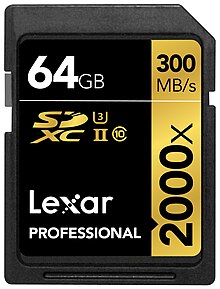This article needs additional citations for verification. (November 2013) |
Lexar International is a brand of flash memory products, formerly American-owned, now manufactured by the Chinese memory company, Longsys.
 | |
| Company type | Subsidiary |
|---|---|
| Industry | Memory storage |
| Founded | 1996 |
| Founders | John Reimer, Mike Liccardo, Paul Wenz, Petro Estakhri |
| Headquarters | San Jose, California, U.S. |
| Products | SD card USB flash drives Solid-state drives Flash memory CompactFlash cards Card readers XQD |
| Parent | Shenzhen Longsys Electronics Co. (2017–present) |
| Website | www |

The Lexar "JumpDrive" trademark was often used synonymously with the term USB flash drives when the technology was first adopted.
History
editEarly years (1996–2006)
editLexar was founded as an American manufacturer of digital media products based in San Jose, California. Products manufactured by Lexar include SD cards, CompactFlash cards, USB flash drives, card readers and solid-state drives.[1] Once a division of Cirrus Logic, Lexar leveraged its parent company's experience in building ATA controllers in developing its own flash controllers. Lexar was spun off from Cirrus Logic in 1996.[2] Lexar was created by Petro Estakhri and Mike Assar.[3]
In 2005, Lexar was awarded $380 million in a lawsuit against Toshiba who copied Lexar's flash memory technology.[3][4]
Under Micron ownership (2006–2017)
editLexar was acquired by Micron Technology in 2006,[5] and subsequently merged with Crucial Technology under the name Lexar Media, a subsidiary of Micron. In September 2007, Lexar extended its agreement with Eastman Kodak Company to develop and market Kodak-branded flash memory products worldwide.[6]
On June 26, 2017, Micron (the then-owner of the brand) announced it was to discontinue the Lexar retail removable media storage business and put part or all of the business up for sale.[7]
Under Longsys ownership (2017–present)
editOn August 31, 2017, the Lexar brand and trademark rights were acquired by Longsys, a flash memory company based in Shenzhen, China.[8]
In 2018, Lexar reentered the flash storage market.[9]
In January 2019, the company unveiled the first SD card with a storage capacity of 1 terabyte (TB).[10]
In December 2019, Lexar demonstrated a prototype 7.5 GB/s PCIe 4.0 SSD which is set to be the world's fastest consumer SSD.[11][12]
In April 2020, Lexar released its world's smallest memory card (nCARD) featuring Xtacking tech from Yangtze Memory Technology (YMTC).[13]
In June 2020, Lexar announced its entry to the DRAM market by unveiling seven different DDR4-2666 memory kits for mainstream laptops and desktops. Lexar also plans to release faster, 3000 MHz and 3200 MHz memory kits in the future, along with kits "with heatsinks and RGB lighting", targeting gamers and enthusiasts.[14]
USB FlashCard
editUSB FlashCard is a flash memory card format developed by Lexar, and announced on December 13, 2004.[15]
There is a wide range of existing memory card formats such as SD, xD, and CompactFlash; the major advantage of USB FlashCard is that the cards are in fact standard USB flash drives.[16] The USB FlashCard uses a modified USB Type A plug which keeps the total thickness of the card to under 4.5 mm. Because of its small size and USB compatibility, a USB FlashCard could, for example, be accessed by either a digital camera or a modern personal computer without the need for a card reader.
Lexar has published the specifications for its USB FlashCard form factor[16] on its website in an open and royalty-free format, in the hopes that other memory card and portable device manufacturers will adopt it.
The specifications for the USB FlashCard published by Lexar show its dimensions to be 31.75 mm × 12 mm × 4.5 mm. The volume is comparable to the widely adopted SD cards (32 mm × 24 mm × 2.1 mm). The USB FlashCard has nearly the same length as the SD card, but is half as wide, and approximately twice as thick.
References
edit- ^ "Lexar Adds Xploder Lite Software To Its Gaming Edition Memory Cards". Lexar Media, Inc. Archived from the original on 10 November 2013. Retrieved 10 November 2013.
- ^ "Lexar Media Holds The Right Cards". Forbes. Retrieved 10 November 2013.
- ^ a b "Lexar Awarded $380 Million in Damages". PhotographyBlog.com. Photo 360 Limited. Retrieved 10 November 2013.
- ^ "Lexar wins patent suit against Toshiba". Silicon Valley Business Journal. March 23, 2005. Retrieved October 7, 2015.
- ^ "Micron Technology, Inc., and Lexar Media, Inc. Announce Completion of Transaction" (Press release). 21 June 2006. Archived from the original on March 9, 2017. Retrieved 28 October 2018.
- ^ "Kodak and Lexar Announce New Extended Five-Year Agreement". Business Wire. 4 September 2007. Retrieved 10 November 2013.
- ^ Hawkins, Jay (26 June 2017). "Micron Technology, Inc. – Micron Discontinuing Lexar Removable Storage Retail Business". Micron.com. Archived from the original on 25 August 2017. Retrieved 24 August 2017.
- ^ "Longsys Acquires Lexar Brand, a Leading Brand for High-Performance Removable Storage Solutions". Longsys.com. 31 August 2017. Archived from the original on 1 September 2017. Retrieved 13 September 2017.
Longsys [..] today announced that it has acquired the Lexar trademark and branding rights from Micron Technology, Inc.
- ^ Wodinsky, Shoshana (17 August 2018). "Lexar's making a glorious return to the world of flash storage". The Verge. Retrieved 27 April 2019.
- ^ "Lexar Announces 1TB 633x SDXC UHS-I card, the behemoth of storage capacity". Lexar. 9 January 2019. Retrieved 10 January 2019.
- ^ Mellor, Chris (2019-12-17). "Lexar demos world's fastest consumer SSD". Blocks and Files. Retrieved 2020-02-21.
- ^ "Lexar Is Testing a 7GB/s PCIe SSD". PCMAG. Retrieved 2020-02-21.
- ^ "Longsys & Yangtze Memory Technologies Revealed the World's Smallest MicroSD Card". Gadgetsay. 21 April 2020. Retrieved 24 April 2020.
- ^ "Lexar launches its first-ever DRAM kits, promises faster RAM is coming". PC Gamer. 19 June 2020. Retrieved 21 June 2020.
- ^ Lexar – Newsroom – Press Releases Archived October 20, 2006, at the Wayback Machine
- ^ a b Lexar – USB FlashCard Archived February 24, 2006, at the Wayback Machine